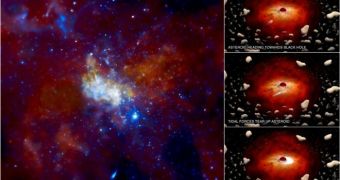According to the results of new observations conducted with the NASA Chandra X-ray Observatory, it would appear that the supermassive black hole at the core of the Milky Way – called Sagittarius A* – is growing by nibbling on asteroids that stray too close to its surface.
The data indicate that the space rocks are first vaporized, and that the black hole only then pulls the gas into its accretion disk. Experts believe that repeating influxes of such matter may help explain the recurring flares Sagittarius A* produces.
Black holes usually produce radiation flares only when large clumps of matter make their way through their event horizon. Astronomers were trying to use this idea to explain the behavior of Sagittarius A*, but failed because they were unable to find any planets or stars falling into the dark behemoth.
The latter consumes everything that's too close to it, including photons making up light beams. Matter is first decompressed and pulled into the object's accretion disk, which is where it's heated to millions of degrees. While in the disk, this matter produces vast amounts of radiations.
What is particularly interesting about Sagittarius A* is the fact that it has been displaying daily flare-ups for a very long time. Usually, the events themselves last for only a few hours, but they make the object from several to nearly 100 times its brightness in X-ray wavelengths.
Chandra has been keeping track of this phenomenon, which was also confirmed using the Very Large Telescope in Chile. The installation is an optical interferometry facility operated by the European Southern Observatory (ESO) at Cerro Paranal.
“People have had doubts about whether asteroids could form at all in the harsh environment near a supermassive black hole. It's exciting because our study suggests that a huge number of them are needed to produce these flares,” Kastytis Zubovas explains.
The investigator holds an appointment as an astronomer with the University of Leicester, in the UK. He was also the lead author of a new paper detailing the findings, which is published in the latest issue of the esteemed journal Monthly Notices of the Royal Astronomical Society.
What researchers are now suggesting is that huge asteroids clouds exist around the black hole. These structures feature trillions of asteroids in total, of which many pass within 100 million miles (161 million kilometers) of Sagittarius A*
Those who do are literally ripped apart by tremendous tidal forces. Their remnants are then funneled into the black hole's ever-hungry mouth. As they fall through the event horizon, the phenomenon is similar in some respects to the atmospheric reentry spacecraft experience when they return to Earth.
“As a reality check, we worked out that a few trillion asteroids should have been removed by the black hole over the 10-billion-year lifetime of the galaxy. Only a small fraction of the total would have been consumed, so the supply of asteroids would hardly be depleted,” University of Amsterdam expert Sera Markoff explains.

 14 DAY TRIAL //
14 DAY TRIAL //